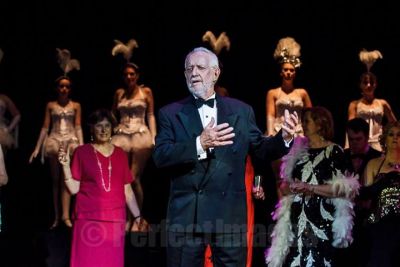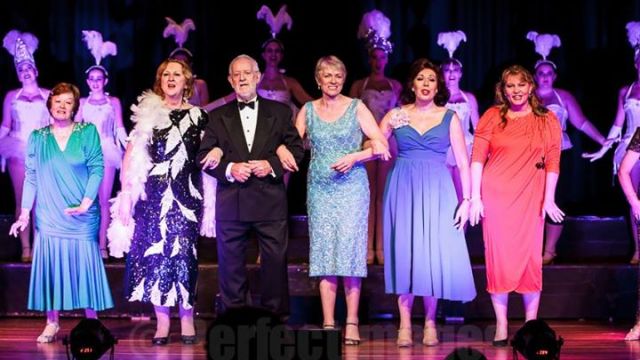Follies
Any company game enough to stage one of Music Theatre’s most challenging and technically demanding works deserves accolades just for the attempt. This weekend Sydney gets not one but two of such works, with Anyone Can Whistle playing a few suburbs south of Follies. Both are brought to us by that master of neurotic introspection, Stephen Sondheim.
For the uninitiated Follies is a musical that pushed boundaries of the form with its highbrow concept and so-honest-it-hurts look at relationships. A group of former showgirls and their partners have a 30-year reunion in the theatre in which they used to perform. It’s the night before the theatre is to be demolished for a car park. Also attending are the ghosts of their younger selves, decked out in showgirl finery, all legs, feathers, and sequins.
As the party progresses memories rekindle, alcohol flows, and the grande dames relive their glory years. Two of the couples (Buddy and Sally, Phyllis and Ben –showgirls who married their stage-door jonnies) expose in their marriages the cracks under their shiny veneers. At show’s end our four protagonists share an emotional meltdown, portrayed as a surreal re-enactment of the follies, with each of the four singing their breakdown as a vaudeville number that is part of the follies routine. The show’s title is multi-layered in meaning, referring to the showgirls’ follies routine, the folly of youth, and the folly of one’s personal life. The show spawned song standards such as Losing My Mind, Broadway Babyand I’m Still Here. It’s a bit like Who’s Afraid of Virginia Woolf, but with feathers. And difficult songs.
Adding to the complexity are traps in the script set by the authors: In One More Kiss the character of Heidi tries recreating her song but doesn’t quite hit the high notes. Meanwhile her younger self echoes the phrases with perfect coloratura. In Ben’s breakdown song Live, Love, Laugh the character forgets his lyrics (the point being that Ben, despite his material success, does not know how to live, laugh, or love) and seeks prompting from the MD. If not executed properly these things come across as though the actors, not their characters, can’t sing or remember lines. And of course it wouldn’t be a Sondheim show without tongue twisters and word play, a la The Story of Lucy and Jessie.

Hornsby’s Follies is a stark, pared back version of this complex show. No opulent setting of a massive, decayed theatre. We have a big black box with no props but the occasional cocktail glass and risers, although no expense was spared on the showgirl costumes. The RSL’s table seating helped set the mood. The pared-back approach had the advantage of intensifying the drama. However, it also had the disadvantage of not defining the point where the characters get caught up in the follies that enact their meltdown. If you knew the show then fine; but someone coming into it cold would need an explanation.
There were many memorable, moving parts. Dominic Augimeri’s Buddy’s Blues was a comic tour-de-force, depicting his philandering as a patter song. Julianne Horne gave one of the most sincere and heartfelt readings of Losing My Mind that I’ve ever heard. She seemed to “get” what the song was really about. The Montage and Who’s That Woman lifted the show. The dialogue in the second half where our two couples switch between speaking with their present partners to their partners’ younger selves was a dramatic high point.
However the show had a bad case of too much respect. It was as if the cast treated the material with such awe and admiration that they didn’t want to rip into it and bring it to life. The static staging and dark, moody lighting didn’t help: I’m a big fan of “just stand there and sing it” but with some of the songs the less-is-more approach could have benefited with a bit of movement, especially with the pared-back set. I know the modern day characters are supposed to be past their dancing days, but they moved so slowly for their ages. The readings were technically proficient but many times I felt I was watching a beautiful museum piece: Follies in Recital. But perhaps that was the point of this staging? Also, the dancing of the showgirl ghosts was not always in sync. However, given the scenes in which the lack of synchronicity happened, I thought that was also intended.
Follies has undergone several re-writes, the latest being the 2011 Broadway revival with Bernadette Peters and Elaine Paige. Hornsby staged the original 1971 version, but inserted an interval and cut the optional extra characters of Vince and Vanessa and their Bolero dance. These choices aided the production.
Peter Novakovich
PerfectImages Photography
Subscribe to our E-Newsletter, buy our latest print edition or find a Performing Arts book at Book Nook.

